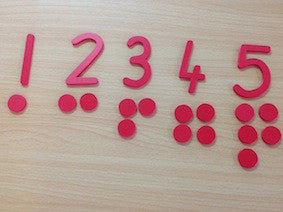Numerals and Counters
Many early childhood classrooms promote counting activities with various numerals and counters, but there are a few elements that make the "Montessori" version unique. Firstly, the use of wood rather than plastic creates a beautiful, inviting aesthetic. The presence of exactly the right number of counters (as opposed to the haphazard provision of random quantities sometimes seen in classrooms) helps to provide a 'control of error' so the child can independently assess his/her counting. The use of one colour throughout, and simple counters (not novelty shapes), also isolates the purpose of the lesson rather than creating a distraction through an array of colours or patterns.
This set also features the numerals as complete, cut-out pieces (rather than numbers printed on a card). This allows the child to physically feel the shape of the numeral, building a muscular memory of its form.
This set comes beautifully presented in a small wooden box with a sliding lid. The inside of the box is divided into two sections - one for the numerals and the other for the counters. This presentation and storage box helps to promote a sense of order and organisation. This can help to encourage the child to engage in responsible behaviours (such as 'packing up' the activity after it is finished) and can help to retain all of the pieces.
The initial portion of the exercise involves the child ordering the numerals. The first time a child uses the activity the teacher should take the lead by actively presenting the steps. After this initial demonstration the child can complete each step independently.
- The numerals are placed in random order on the bottom of the table or mat (closest to the child). During the initial presentation the teacher will mix them up, after this the child can take them out of the box independently.
- The "1" is placed on the top, left hand corner of the table/mat. During the initial presentation the teacher will do this, but after this the child might do this independently or after the teacher asks "where is 'one'?"
- The "2" is placed to the right of the "1" (with a little bit of space between them so the counters don't get mixed up later!). During the initial presentation the teacher will do this, but then the child might do it independently or after the teacher asks "what comes after one?".
- This is repeated until all ten numerals are in a row.
- A single counter is placed under the '1'.
- Two counters are placed under the '2'. During the initial presentation the teacher shows the child how to take these from the box and place these down one at a time while counting out loud. This helps to encourage the child to repeat the task in a similarly orderly, careful and deliberate manner. Otherwise the child might 'snatch' several counters out at once and become mixed up by how many are in his/her hand.
- This is repeated until all the correct quantities of counters are placed under the corresponding numerals. When the child does the task independently he or she will notice that all the counters have been used at the end if he/she has counted correctly. Any leftover counters will act as a self-correcting mechanism to help the child identify an earlier error.
The left-to-right presentation of the cards reflects the way that we read equations (and sentences). It is important to consider the amount of space that you will need to fit all ten cards in a row. Try to familiarise yourself with the breadth of the activity so that you can invite the child to use it in an appropriate spot. It can break the child's focus if you get halfway through the lesson and realise you're running out of space.
When you place the counters out it is useful to group them in pairs rather than making one long column of single counters. That is, the '2' will have two counters sitting side by side and the '3' will have two counters side by side with the third sitting below the third. This pattern clearly highlights the difference between odd and even numbers - with the odd numbers having a 'spare' and the even numbers being in 'pairs'.
If you choose to present half of the numerals (such as 1-5), perhaps as remedial revision for a child who is struggling to complete the exercise with all ten, then it is important to remember to adjust the number of counters accordingly. If you are presenting the number cards 1, 2, 3, 4 and 5 then there should only be 15 counters. This allows the 'control of error' to remain present.
Below is an image of the Numerals and Counters presentation. Please note, this photograph actually shows an older version of the activity from my own classroom with numeral cards rather than cut-out numerals. It is, however, equally relevant for an illustration of the layout and presentation of the activity!


